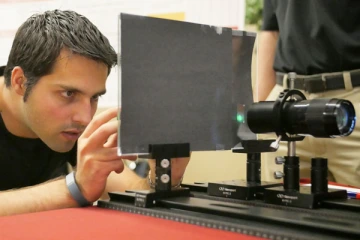Honeywell Scopes Out Talent Through Engineering Design Program

Team 16012 pose with their turbulence-compensated table mechanism, which earned them the Honeywell-sponsored Excellence in Aerospace Electronic System Design award at Design Day 2017.
Project mentors and Design Day judges with veteran corporate partner tout the benefits for the company, and soon-to-be graduates.
Phoenix-based Honeywell Aerospace has been a regular partner to the UA Engineering Design Program, supporting over 60 projects in the last 10 years. Many of the projects build on students’ work from one year to the next.
The chance to work with a Fortune 100 company is worth each student’s weight in gold, said Marla Peterson, senior technical manager for production support at Honeywell, a frequent judge at Design Day who graduated from the UA with her bachelor’s degree in systems engineering in 1983.

Jessica Carlyle Owens (left) and Andrew Daniel Rocha (right) hold up their $250 team leadership prizes, awarded to them by veteran Design Day sponsor Honeywell during the 2017 event.
“It’s kind of like an introduction, an interview without really being an interview.”
Honeywell engineer Alex Mirzamoghadam, who has been mentoring University of Arizona engineering students on their capstone projects since 2008, added that students’ time with the company is the real deal. Honeywell isn’t making up busywork for them.
“For the students, it’s definitely a good experience,” he said. “It’s a real problem they’re working to solve. It’s not an academic problem.”
Ron Rich, another Design Day judge and UA alumnus, graduated with his bachelor’s degree from the aerospace engineering program in 1982 and now serves as director of engineering for auxiliary power systems at Honeywell. He said it’s not unheard of for the company to patent work that comes out of design projects and acknowledge student contributions in the patent.
Honeywell ends up with new intellectual property, and students earn a serious résumé booster.
“They surprise me all the time in how innovative they can be because they’re not encumbered by predisposed thoughts,” Rich said. “They’re pretty free-thinking.”
For Peterson, it’s exciting to see what students are learning in the classroom. Sometimes, she said, students bring up principles that Honeywell engineers haven’t thought about since they were in college themselves, but that knowledge is exactly what’s needed to solve a problem.
A Mutual Benefit for Students and Sponsors

Team 1405’s holographic head-up display earned them both the Honeywell Excellence in Aerospace Electronic System Design Award and the II-VI Optical Systems Award for Best Use of Optical Design and Technology at Design Day 2015.
Mirzamoghadam is such a big proponent of senior design programs that he co-authored a 2013 paper for the American Society of Mechanical Engineers about the value of iterative student projects.
“Honeywell benefits from a low-cost design,” he said, “and from these students potentially joining Honeywell after they graduate.”
Peterson said it would be great if Honeywell could hire every UA Engineering student with whom the company works, and Rich joked that he’s been accused of hiring too many students from the program.
“I’ve got some really good engineers who have come out of the program, and I’m very impressed,” he said. “They’re coming out better equipped.”
Partnering with the UA gives Honeywell a chance to contribute to the development of the type of employee the company is seeking. That means excellent engineers, of course. It also means engineers with a solid grasp of the economics behind a project, time management skills, and an understanding that the real world is an interdisciplinary place.
“I think the project has really evolved in terms of the intrinsic value. It takes all disciplines to be successful,” he said. “For me, it’s a way of giving back as I progress in my career.”

